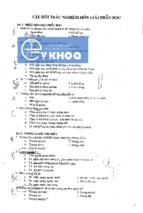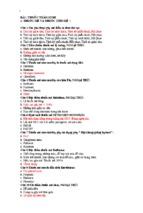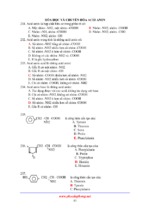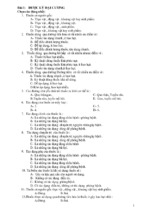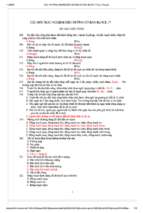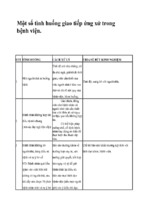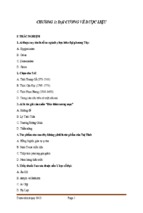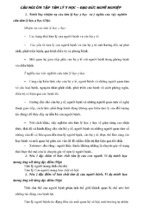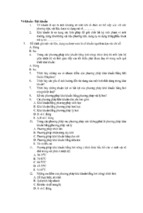Dr Claire Foley, Senior House Officer in Obstetrics, is sitting in the Doctors’ Office in the
Accident and Emergency Department at St Luke’s Hospital. She is waiting to speak to Dr
Tim Jackson, one of the Senior House Officers in the department, who has asked her to see
a patient. Dr Jackson enters the office.
**********
Dr Jackson: Oh, there you are, Claire.
Dr Foley: Hello, Tim.
Dr Jackson: Thanks for coming down so quickly.
Dr Foley: Oh, it wasn’t a problem. I’m all through seeing my patients and, fortunately,
there’s nobody at all in the delivery room at the moment. What can I do for you?
Dr Jackson: I wanted you to see Mrs Emma Taylor. She’s a 27-year-old lady who is about 32
weeks pregnant. She’s been sent to Casualty complaining of epigastric pain.
Dr Foley: Is this her first pregnancy?
Dr Jackson: No, but her only previous pregnancy was about 5 years ago when she had
a miscarriage at about 26 weeks’ gestation.
Dr Foley: What’s the pain like?
Dr Jackson: It started 2 or 3 days ago and radiates to the right hypochondrium. She’s
especially alarmed by it because she had a similar pain during her previous pregnancy and
shortly before the miscarriage.
Dr Foley: Did she? Have there been any problems with this pregnancy so far and is there
any other history of note?
Dr Jackson: No, she’s had no problems whatsoever. As for any other history, she’s usually
very fit and she’s taking no medications at all.
Dr Foley: That’s good. Did you find anything on examination?
Dr Jackson: Nothing much. She’s got some mild epigastric tenderness and examining her
abdomen confirms that she’s about 32 weeks pregnant. Her blood pressure is a bit high at
160/105 (mm Hg) and she’s got some mild pitting edema of both ankles.
Dr Foley: Oh really. Has she got a temperature?
Dr Jackson: No, no, she’s apyrexial and actually looks quite well.
Dr Foley: In fact, from what you’ve said I’m a bit concerned. What investigations have you
done? And, has she had her urine tested yet?
Dr Jackson: Yes, she has and I’ve done some bloods as well. The nurse should be along
with the results any time now.
Dr Foley: I see. What bloods tests have you actually done?
Dr Jackson: Oh, just the usual. A full blood count, urea, electrolytes and a blood glucose.
Dr Foley: That’s fine. Oh, here’s the nurse now. Is that the urine result now?
Nurse: Yes, it is, Doctor.
Dr Jackson: Thank you. Hmm, let me see… she appears to have ++ of protein.
Dr Foley: I was worried she might. We’d better admit her to the ward.
Dr Jackson: What do you think is the problem? And is her epigastric pain relevant?
Dr Foley: Well, she has hypertension, peripheral edema and proteinuria, and in a woman like
this that suggests she’s got PET or pre-eclampsic toxemia. I’m not sure how relevant the
epigastric pain is but, as you said, she did have it during the previous unsuccessful
pregnancy.
Dr Jackson: What are you going to do?
Dr Foley: Get her transferred to our ward as soon as possible and then I’ll do an ultrasound
to check the baby. I’ll also speak with James Blair, my Senior Registrar, and get him to come
and see Mrs Taylor.
Dr Jackson: Thanks very much. I hope everything works out all right.
**********
One hour later, Mrs Taylor has been transferred to the Ward. Dr Foley and Mr Blair are
discussing her problem in the Ward office.
Dr Foley: Is her epigastric pain relevant?
Mr Blair: Oh yes. I think it probably is. Epigastric pain is a recognized feature of PET and,
unfortunately, generally means there’s hepatic involvement.
Dr Foley: Does it? We haven’t done her liver function tests.
Mr Blair: That’s all right. We can do them now. Was her ultrasound all right?
Dr Foley: Yes. I did it as soon as she arrived up here. The fetus is alive and appears to be
normal and of exactly the right gestation period. Ah, here are the blood results.
Mr Blair: Can I see them?
Dr Foley: Of course. Here you are.
Mr Blair: Ah-ha. Let’s see now. Well, her hemoglobin is only 8.5g and it shows a
microangiopathic picture. Her platelet count is only 25, although her white count is fine.
Dr Foley: That platelet count is very low. What about her urea and electrolytes and her blood
glucose?
Mr Blair: They’re all normal.
Dr Foley: What does all that add up to?
Mr Blair: First of all, she’s obviously got quite severe pre-eclampsia. There’s also a subset of
such patients who have something called the HELLP syndrome.
Dr Foley: What’s that?
Mr Blair: It stands for hemolysis, elevated liver enzymes and low platelets. We don’t know
whether her LFTs are abnormal, but it’s quite likely in view of the epigastric pain.
Dr Foley: Could it be due to anything else?
Mr Blair: We need to think about other conditions like acute fatty liver of pregnancy and
possibly septicemia. The hemolytic-uremic syndrome is unlikely because of her normal urea
and electrolytes and so is thrombotic thrombocytopenic purpura because she hasn’t got a
fever and there aren’t any neurological signs.
Dr Foley: Presumably we ought to do some blood cultures now, and her LFTs.
Mr Blair: Yes. She’ll also need some clotting studies done. I would do her prothrombin time
and a partial thromboplastin time, but it might be useful to check with one of the
hematologists about exactly what we should do.
Dr Foley: What about the pregnancy?
Mr Blair: Well, as soon as we get the blood picture sorted out, she’s going to need a
cesarean section. Patients with severe pre-eclampsic toxemia can go downhill rapidly until
delivery.
Dr Foley: Is she likely to need transfusing?
Mr Blair: We certainly need to have platelets on hand for her at the time of the section.
Dr Foley: Are she and the baby going to be all right?
Mr Blair: I hope so. Obviously, there are risks involved for both of them. Once Mrs Taylor is
delivered things should begin to improve although her liver function may
actually deteriorate for a few days before it starts to recover. We’d better go and see her
and explain what’s going on.
- Xem thêm -

